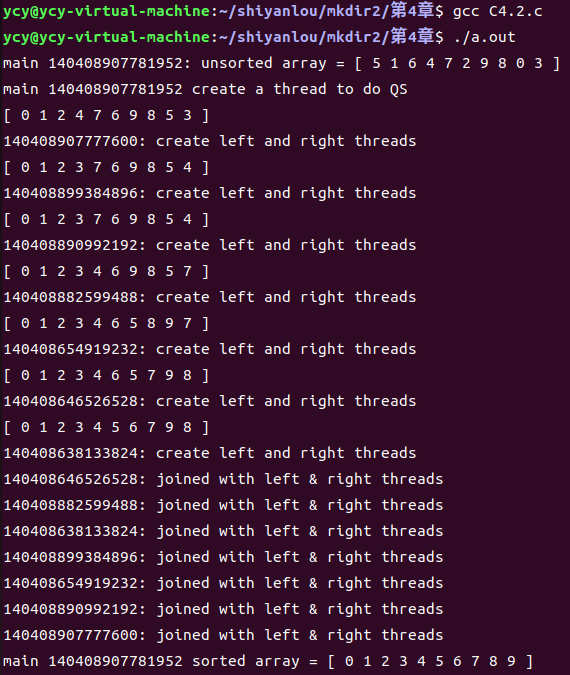《Unix/Linux系统编程》学习笔记7
第四章 并发编程
一、知识点归纳
(一)并行计算导论
1.顺序算法与并行算法
| 顺序算法 | 并行算法 |
|
begin step_1 step_2 …… step_n end // next step |
cobegin task_1 task_2 …… task_n coend // next step |
2.并行性与并发性
(二)线程
1.线程的原理
2.线程的优点
-
(1)线程创建和切换速度更快
-
(2)线程的响应速度更快
-
(3)线程更适合并行计算
3.线程的缺点
-
(1)由于地址空间共享,线程需要来自用户的明确同步。
-
(2)许多库函数可能对线程不安全。
-
(3)在单CPU系统上,使用线程解决问题实际上要比使用顺序程序慢,这是由在运行时创建线程和切换上下文系统开销造成的。
(三)线程操作
(四)线程管理函数
Pthread 库提供了用于线程管理的以下 API。
pthread_create(thread, attr, function, arg): create thread
pthread_exit(status) : terminate thread
pthread_cancel(thread) : cancel thread
pthread_attr_init(attr) : initialize thread attributes
pthread_attr_destroy(arr) : destroy thread attributes1.创建线程
使用 pthread_create() 函数创建线程。
int pthread_create(pthread_t *pthread_id, pthread_attr_t *attr, void *(*func)(void *),void *arg); 如果成功则返回0,如果失败则返回错误代码。pthread_create()函数的参数为
- pthread_id 是指向 pthread_t 类型变量的指针。它会被操作系统内核分配的唯一线程ID填充。
2.线程ID
3.线程终止
4.线程连接
(五)线程示例程序(见实践内容)
1.用线程计算矩阵的和
2.用线程快速排序
(六)线程同步
- 竞态条件:当多个线程试图修改同一共享变量或数据结构时,修改结果取决于线程的执行顺序。
1.互斥量
最简单的同步工具是锁,它允许执行实体仅在有锁的情况下才能执行。在 Pthread 中,锁被称为互斥量,意思是相互排斥。互斥变量是用 pthread_mutex_t 类型声明,在使用之前必须对它们进行初始化。有两种方法可以初始化互斥量。
- 一种是静态方案,如:
pthread_mutex_t m = PTHREAD_MUTEX_INITIALIZER定义互斥量 m,并使用默认属性对其进行初始化。 - 另一种是动态方案,使用
pthread_mutex_init()函数,可通过 attr 参数设置互斥属性,如:pthread_mutex_init(pthread_mutex_t *m, pthread_mutexattr_t, *attr);通常,attr 参数可以设置为 NULL,作为默认属性。
2.死锁预防
互斥量使用封锁协议。如果某线程不能获取互斥量,就会被阻塞,等待互斥量解锁后再继续。在任何封锁协议中,误用加锁可能会产生一些问题。最常见和突出的问题是死锁。死锁是一种状态,在这种状态下,许多执行实体相互等待,因此都无法继续下去。
与竞态条件类似,死锁决不能存在于并发程序中。有许多方法可以解决可能的死锁问题,其中包括死锁预防、死锁规避、死锁检测和恢复等。在实际系统中,唯一可行的方法是死锁预防,试图在设计并行算法时防止死锁的发生。一种简单的死锁预防方法是对互斥量进行排序,并确保每个线程只在一个方向请求互斥量,这样请求序列中就不会有循环。
但是,仅使用单向加锁请求来设计每个并行算法是不可能的。在这种情况下,可以使用条件加锁函数 pthread_mutex_trylock() 来预防死锁。如果互斥量已被加锁,则 trylock()函数会立即返回一个错误。在这种情况下,调用线程可能会释放它已经获取的一些互斥量以便进行退避,从而让其他线程继续执行。在上面的交叉加锁示例,我们可以重新设计一个线程,例如 T1,利用条件加锁和退避来预防死锁。
/*Thread T1*/
while(1){
lock(m1);
if(!trylock(m2))
unlock(m1);
else
break;
}3.条件变量
4.生产者—消费者问题
5.信号量
- 信号量是进程同步的一般机制。
6.屏障
7.用并发线程解线性方程式
8.Linux 中的线程
与许多其他操作系统不同,Linux 不区分进程和线程。对于 Linux 内核,线程只是一个与其他进程共享某些资源的进程。在 Linux 中,进程和线程都是由 clone() 系统调用创建的,具有以下原型:
int clone(int (*fn)(void *), void *child_stack, int flags, void *arg)可以看出,clone()更像是一个线程创建函数。它创建一个子进程来执行带有 child_stack的函数fn(arg)。flag 字段详细说明父进程和子进程共享的资源。
(七)用户级线程
二、问题与解决思路
(一)问题1:error: conflicting types for ‘qsort’; have ‘void *(void *)’

解决方案:qsort()这个函数名被占用了,将函数名 qsort修改成其它名字, 比如改成 qsort1。
三、实践内容与截图
(一)用线程计算矩阵的和
#include<stdio.h>
#include<stdlib.h>
#include<pthread.h>
#define N 4
int A[N][N],sum[N];
void *func(void *arg)
{
int j,row;
pthread_t tid=pthread_self();
row=(int)arg;
printf("Thread %d [%lu] computes sum of row %d\n",row,tid,row);
for(j=0;j<N;j++)
sum[row]+=A[row][j];
printf("Thread %d [%lu] done: sum[%d] = %d\n",row,tid,row,sum[row]);
pthread_exit((void*)0);
}
int main(int argc,char *argv[])
{
pthread_t thread[N];
int i,j,r,total=0;
void *status;
printf("Main: initialize A matrix\n");
for(i=0;i<N;i++)
{
sum[i]=0;
for(j=0;j<N;j++)
{
A[i][j]=i*N+j+1;
printf("%4d ",A[i][j]);
}
printf("\n");
}
printf("Main: create %d threads\n",N);
for(i=0;i<N;i++)
{
pthread_create(&thread[i],NULL,func,(void *)i);
}
printf("Main: try to join with thread\n");
for(i=0;i<N;i++)
{
pthread_join(thread[i],&status);
printf("Main: joined with %d [%lu]: status=%d\n",i,thread[i],(int)status);
}
printf("Main: compute and print total sum: ");
for(i=0;i<N;i++)
total+=sum[i];
printf("total = %d\n",total);
pthread_exit(NULL);
}(二)用并发线程快速排序
#include<stdio.h>
#include<stdlib.h>
#include<pthread.h>
typedef struct{
int upperbound;
int lowerbound;
}PARM;
#define N 10
int a[N]={5,1,6,4,7,2,9,8,0,3};
int print()
{
int i;
printf("[ ");
for(i=0;i<N;i++)
printf("%d ",a[i]);
printf("]\n");
}
void *qsort1(void *aptr)
{
PARM *ap,aleft,aright;
int pivot,pivotIndex,left,right,temp;
int upperbound,lowerbound;
pthread_t me,leftThread,rightThread;
me=pthread_self();
ap=(PARM *)aptr;
upperbound=ap->upperbound;
lowerbound=ap->lowerbound;
pivot=a[upperbound];
left=lowerbound-1;
right=upperbound;
if(lowerbound>=upperbound)
pthread_exit(NULL);
while(left<right)
{
do{left++;}while(a[left]<pivot);
do{right--;}while(a[right]>pivot);
if(left<right){
temp=a[left];
a[left]=a[right];
a[right]=temp;
}
}
print();
pivotIndex=left;
temp=a[pivotIndex];
a[pivotIndex]=pivot;
a[upperbound]=temp;
aleft.upperbound=pivotIndex-1;
aleft.lowerbound=lowerbound;
aright.upperbound=upperbound;
aright.lowerbound=pivotIndex+1;
printf("%lu: create left and right threads\n",me);
pthread_create(&leftThread,NULL,qsort1,(void *)&aleft);
pthread_create(&rightThread,NULL,qsort1,(void *)&aright);
pthread_join(leftThread,NULL);
pthread_join(rightThread,NULL);
printf("%lu: joined with left & right threads\n",me);
}
int main(int argc,char *argv[])
{
PARM arg;
int i,*array;
pthread_t me,thread;
me=pthread_self();
printf("main %lu: unsorted array = ",me);
print();
arg.upperbound=N-1;
arg.lowerbound=0;
printf("main %lu create a thread to do QS\n",me);
pthread_create(&thread,NULL,qsort1,(void *)&arg);
pthread_join(thread,NULL);
printf("main %lu sorted array = ",me);
print();
}(三)Pthread中的互斥量
#include<stdio.h>
#include<stdlib.h>
#include<pthread.h>
#define N 4
int A[N][N];
int total=0;
pthread_mutex_t *m;
void *func(void *arg)
{
int i,row,sum=0;
pthread_t tid=pthread_self();
row=(int)arg;
printf("Thread %d [%lu] computes sum of row %d\n",row,tid,row);
for(i=0;i<N;i++)
sum+=A[row][i];
printf("Thread %d [%lu] update total with %d : ",row,tid,sum);
pthread_mutex_lock(m);
total+=sum;
pthread_mutex_unlock(m);
printf("Thread %d : total = %d\n",row,total);
}
int main(int argc,char *argv[])
{
pthread_t thread[N];
int i,j,r;
void *status;
printf("Main: initialize A matrix\n");
for(i=0;i<N;i++){
for(j=0;j<N;j++){
A[i][j]=i*N+j+1;
printf("%4d ",A[i][j]);
}
printf("\n");
}
m=(pthread_mutex_t *)malloc(sizeof(pthread_mutex_t));
pthread_mutex_init(m,NULL);
for(i=0;i<N;i++){
printf("Main: create thread %d \n",i);
pthread_create(&thread[i],NULL,func,(void *)i);
}
printf("Main: try to join with threads\n");
for(i=0;i<N;i++){
pthread_join(thread[i],&status);
printf("Main: joined with %d [%lu]: status=%d\n",i,thread[i],(int)status);
}
printf("Main: total = %d\n",total);
pthread_mutex_destroy(m);
pthread_exit(NULL);
}





【推荐】国内首个AI IDE,深度理解中文开发场景,立即下载体验Trae
【推荐】编程新体验,更懂你的AI,立即体验豆包MarsCode编程助手
【推荐】抖音旗下AI助手豆包,你的智能百科全书,全免费不限次数
【推荐】轻量又高性能的 SSH 工具 IShell:AI 加持,快人一步
· 阿里最新开源QwQ-32B,效果媲美deepseek-r1满血版,部署成本又又又降低了!
· 开源Multi-agent AI智能体框架aevatar.ai,欢迎大家贡献代码
· Manus重磅发布:全球首款通用AI代理技术深度解析与实战指南
· 被坑几百块钱后,我竟然真的恢复了删除的微信聊天记录!
· AI技术革命,工作效率10个最佳AI工具